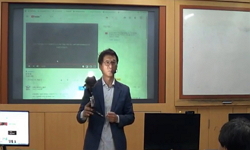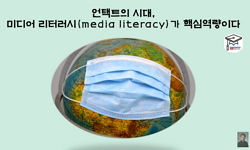Due to the Fourth Industrial Revolution, IT technology has a huge influence and dominates society as a whole. Among them, "Virtual Reality (VR)" has brought virtual or imaginary world into reality by enhancing expressiveness of computer graphics techn...
http://chineseinput.net/에서 pinyin(병음)방식으로 중국어를 변환할 수 있습니다.
변환된 중국어를 복사하여 사용하시면 됩니다.
- 中文 을 입력하시려면 zhongwen을 입력하시고 space를누르시면됩니다.
- 北京 을 입력하시려면 beijing을 입력하시고 space를 누르시면 됩니다.

증강현실의 의미적 개념과 종교적 믿음의 관계에 관한 고찰 - 성경에 기록된 사건을 중심으로 - = A study on the relation between the semantic concept of augmented reality and religious faith. - Focused on the written events in the Bible -
한글로보기부가정보
다국어 초록 (Multilingual Abstract)
Faith has to do with the invisible world. God can not be seen by the human eye, and nobody can prove his existence. Faith is evidence of things we do not see. The proof that there is something invisible is the fact that we believe it. Through the meaning of 'augmented reality' that makes us know that we are invisible but exists, the interpretation of 'faith' from the modern point of view is the core of our research. The subject of the study deals with the story of the prophet "Elisha" appearing in the Book of Kings of the Old Testament in the Bible. The account recorded in 2 Kings 6: 8-17 shows that the king of Syria besieged Dothan, and at this time Elisha saw that the God of heaven descended and kept him, but his servant, Gehazi, A phenomenon that can not be seen is recorded. This is a scene that is supposed to be a dramatic visual effect of God's work and is very similar to the conceptual nature of augmented reality. The reality we are seeing can be seen as being experienced, perceived, and believing.
In other words, even our reality can be explained as the illusion if there is no eye. Augmented reality is a problem of interaction for the continuity of the real world and the virtual world, and it is on the same line with the problem of cognitive science that grasps the essence of the interaction of human mind and artifact.
The conclusion of this study is that first, 'seeing' is not our will but limited cognitive activity in a given environment. Second, 'faith' becomes a medium of modern conception that can be seen by God. Third, the augmented reality is present, but by using special media to make invisible data visible to reality, it is consistent with the modern interpretation of the Bible, "The truth of things hoped for and evidence of things not seen" (Hebrews 11: 1) Can be.
Due to the Fourth Industrial Revolution, IT technology has a huge influence and dominates society as a whole. Among them, "Virtual Reality (VR)" has brought virtual or imaginary world into reality by enhancing expressiveness of computer graphics technology. Augmented Reality (AR), which is similar to this virtual reality technology, is one of the technologies recently attracted by mixed reality contents which is a mixture of reality and virtual images. In order to use this augmented reality, a media display device capable of running a program such as a smart device is required. When a specific image of reality is illuminated through the camera of this apparatus, various types of augmented reality contents previously produced by the program are displayed. The data shown at this time is matched with the image of the real world, and it appears as if it exists in the place. Because it is data that can only be seen through special media, we can not usually see it with our eyes. 'To see' should be premised on the light. This is not what I see as I see it, but through the 'light that shows' as much as we can see. That is, it does not exist and does not exist. We can not see directly with our eyes, but the digital data that make up the content exists in its own way in the space. The Fourth Industrial Revolution has enabled us to directly identify and feel electronic data that we could not have seen in the past through human eyes through special media.
Faith has to do with the invisible world. God can not be seen by the human eye, and nobody can prove his existence. Faith is evidence of things we do not see. The proof that there is something invisible is the fact that we believe it. Through the meaning of 'augmented reality' that makes us know that we are invisible but exists, the interpretation of 'faith' from the modern point of view is the core of our research. The subject of the study deals with the story of the prophet "Elisha" appearing in the Book of Kings of the Old Testament in the Bible. The account recorded in 2 Kings 6: 8-17 shows that the king of Syria besieged Dothan, and at this time Elisha saw that the God of heaven descended and kept him, but his servant, Gehazi, A phenomenon that can not be seen is recorded. This is a scene that is supposed to be a dramatic visual effect of God's work and is very similar to the conceptual nature of augmented reality. The reality we are seeing can be seen as being experienced, perceived, and believing.
In other words, even our reality can be explained as the illusion if there is no eye. Augmented reality is a problem of interaction for the continuity of the real world and the virtual world, and it is on the same line with the problem of cognitive science that grasps the essence of the interaction of human mind and artifact.
The conclusion of this study is that first, 'seeing' is not our will but limited cognitive activity in a given environment. Second, 'faith' becomes a medium of modern conception that can be seen by God. Third, the augmented reality is present, but by using special media to make invisible data visible to reality, it is consistent with the modern interpretation of the Bible, "The truth of things hoped for and evidence of things not seen" (Hebrews 11: 1) Can be.
국문 초록 (Abstract)
종교적 믿음은 보이지 않는 세계와 관련이 있다. 보이지 않는 것들이 존재한다는 증거는 우리가 그것을 믿고 있다는 사실이다. 다시 말해 종교적 믿음은 보지 못하는 것들의 증거가 된다. 눈에 보이지 않지만 존재하고 있음을 알게 해주는 ‘증강현실’의 의미를 통해 종교적 ‘믿음’에 대한 현대적 관점에서의 해석이 본 연구의 핵심이다. 연구의 대상은 성경에 기록된 사건 중 구약성경 열왕기 하권에 등장하는 예언자 엘리사에 관한 이야기를 다룬다. 열왕기하 6장 8절에서 17절에 기록된 내용은 아람왕이 도단성을 포위한 사건으로 이 때에 ‘엘리사’는 하나님의 천군이 내려와 지켜주고 있음을 보고 있으나, 그의 종인 게하시는 보지 못하는 현상이 기록되어 있다. 이 사건은 하나님의 역사함이 인간의 눈에 극적인 시각 효과로 나타났을 것으로 추측되는 장면이며, 증강현실의 개념적 성격과 매우 유사한 장면이다. 증강현실은 현실세계와 가상세계의 연속성을 위한 상호작용에 대한 문제이며 나아가 사람의 마음과 인공물의 상호작용의 본질을 파악하는 인지과학의 문제와 같은 선상에 놓여 있다고 볼 수 있다.
본 연구의 결론은 첫째, ‘본다’는 것은 우리의 의지가 아니라 주어진 환경 내에서 제한적으로 허락된 인지작용이라는 것이다. 둘째로, 따라서 ‘믿음’은 하나님이 보여주고자 하는 것을 볼 수 있는 종교적 관점의 매체이다. 셋째, 증강현실의 특성은 “바라는 것들의 실상이요 보지 못하는 것들의 증거”(히 11:1)라는 성경말씀의 의미에 적합한 표현방법임을 수 있다.
4차 산업혁명으로 인해 IT기술은 막대한 영향력을 행사하며 사회 전반을 지배하고 있다. 그 중 ‘가상현실(Virtual Reality, VR)’은 컴퓨터 그래픽 기술의 표현력 향상에 힘입어 불가능하거나 비...
4차 산업혁명으로 인해 IT기술은 막대한 영향력을 행사하며 사회 전반을 지배하고 있다. 그 중 ‘가상현실(Virtual Reality, VR)’은 컴퓨터 그래픽 기술의 표현력 향상에 힘입어 불가능하거나 비현실적 세계를 가상으로 만들어내게 되었다. AR/AR을 이용하기 위해서는 스마트 기기 등 소프트웨어 구동이 가능한 미디어 디스플레이 장치가 필요하다. 이러한 매체를 통해서만 볼 수 있는 데이터이기 때문에 일반적으로 인간의 눈만으로는 콘텐츠를 볼 수가 없다, ‘본다’는 것은 빛이 전제되어야 한다. 이는 내가 보고 싶은 만큼 보는 것이 아니라, 보여주는 만큼만 보게 되는 것이다. 즉, 볼 수 없다고 존재하지 않는 것은 아니다. 우리의 눈으로 직접 볼 수 없을 뿐, 콘텐츠를 구성하는 디지털 데이터는 무선 통신 기술의 힘으로 공간에 자신만의 방법으로 존재하고 있는 것이다. 기술은 바로 우리가 과거에는 직접 볼 수 없었던 전자 데이터들을 특별한 매체를 통해 인간의 눈으로 직접 확인하고 느낄 수 있도록 해주었다.
종교적 믿음은 보이지 않는 세계와 관련이 있다. 보이지 않는 것들이 존재한다는 증거는 우리가 그것을 믿고 있다는 사실이다. 다시 말해 종교적 믿음은 보지 못하는 것들의 증거가 된다. 눈에 보이지 않지만 존재하고 있음을 알게 해주는 ‘증강현실’의 의미를 통해 종교적 ‘믿음’에 대한 현대적 관점에서의 해석이 본 연구의 핵심이다. 연구의 대상은 성경에 기록된 사건 중 구약성경 열왕기 하권에 등장하는 예언자 엘리사에 관한 이야기를 다룬다. 열왕기하 6장 8절에서 17절에 기록된 내용은 아람왕이 도단성을 포위한 사건으로 이 때에 ‘엘리사’는 하나님의 천군이 내려와 지켜주고 있음을 보고 있으나, 그의 종인 게하시는 보지 못하는 현상이 기록되어 있다. 이 사건은 하나님의 역사함이 인간의 눈에 극적인 시각 효과로 나타났을 것으로 추측되는 장면이며, 증강현실의 개념적 성격과 매우 유사한 장면이다. 증강현실은 현실세계와 가상세계의 연속성을 위한 상호작용에 대한 문제이며 나아가 사람의 마음과 인공물의 상호작용의 본질을 파악하는 인지과학의 문제와 같은 선상에 놓여 있다고 볼 수 있다.
본 연구의 결론은 첫째, ‘본다’는 것은 우리의 의지가 아니라 주어진 환경 내에서 제한적으로 허락된 인지작용이라는 것이다. 둘째로, 따라서 ‘믿음’은 하나님이 보여주고자 하는 것을 볼 수 있는 종교적 관점의 매체이다. 셋째, 증강현실의 특성은 “바라는 것들의 실상이요 보지 못하는 것들의 증거”(히 11:1)라는 성경말씀의 의미에 적합한 표현방법임을 수 있다.
참고문헌 (Reference)
1 위키백과, "초기_인류의_불의_이용"
2 이기호, "증강현실의 공간적 개념에 관한 연구" 예술과미디어학회 12 (12): 213-232, 2013
3 이동진, "증강현실에서의 프레즌스 경험에 관한 요인분석" 한국일러스아트학회 15 (15): 135-142, 2012
4 조용재, "증강현실 공간의 지각 특성-메를로 퐁티의 지각의 현상학을 중심으로" 홍익대학교 2017
5 위키백과, "인류의_진화"
6 이기호, "우표의 증강현실 적용에 관한 연구" 한국만화애니메이션학회 (33) : 503-529, 2013
7 양유빈, "보이는 것과 보는 것" 홍익대학교 2017
8 박영근, "모바일 기반의 증강현실지적도 구현에 관한 연구" 한국지적정보학회 13 (13): 51-61, 2011
9 방경란, "기하학적 형태의 교구와 조형 표현과의 관계" 홍익대학교 2005
10 네이버 지식백과, "교회용어사전, 검색어 : 현현"
1 위키백과, "초기_인류의_불의_이용"
2 이기호, "증강현실의 공간적 개념에 관한 연구" 예술과미디어학회 12 (12): 213-232, 2013
3 이동진, "증강현실에서의 프레즌스 경험에 관한 요인분석" 한국일러스아트학회 15 (15): 135-142, 2012
4 조용재, "증강현실 공간의 지각 특성-메를로 퐁티의 지각의 현상학을 중심으로" 홍익대학교 2017
5 위키백과, "인류의_진화"
6 이기호, "우표의 증강현실 적용에 관한 연구" 한국만화애니메이션학회 (33) : 503-529, 2013
7 양유빈, "보이는 것과 보는 것" 홍익대학교 2017
8 박영근, "모바일 기반의 증강현실지적도 구현에 관한 연구" 한국지적정보학회 13 (13): 51-61, 2011
9 방경란, "기하학적 형태의 교구와 조형 표현과의 관계" 홍익대학교 2005
10 네이버 지식백과, "교회용어사전, 검색어 : 현현"
11 현우식, "과학으로 기독교 새로 보기" 연세대학교출판부 2012
12 우성희, "게슈탈트 시지각 이론을 활용한 편집디자인 교육에 관한 연구" 부경대학교 교육대학원 2006
13 네이버 지식백과, "검색어 : 원격현전"
14 "http://dogokch.com/rb/?c=15/16&uid=193"
동일학술지(권/호) 다른 논문
-
- 한국만화애니메이션학회
- 이성균
- 2019
- KCI등재
-
- 한국만화애니메이션학회
- 김종국
- 2019
- KCI등재
-
- 한국만화애니메이션학회
- 박경철
- 2019
- KCI등재
-
말칸(말풍선)의 소리 이미지에 대한 연구 - 발화되지 않는 말칸
- 한국만화애니메이션학회
- 김동호
- 2019
- KCI등재
분석정보
인용정보 인용지수 설명보기
학술지 이력
| 연월일 | 이력구분 | 이력상세 | 등재구분 |
|---|---|---|---|
| 2027 | 평가예정 | 재인증평가 신청대상 (재인증) | |
| 2021-01-01 | 평가 | 등재학술지 유지 (재인증) |  |
| 2018-01-01 | 평가 | 등재학술지 유지 (등재유지) |  |
| 2015-01-01 | 평가 | 등재학술지 유지 (등재유지) |  |
| 2011-01-01 | 평가 | 등재학술지 선정 (등재후보2차) |  |
| 2010-01-01 | 평가 | 등재후보 1차 PASS (등재후보1차) |  |
| 2009-01-01 | 평가 | 등재후보학술지 유지 (등재후보2차) |  |
| 2008-01-01 | 평가 | 등재후보 1차 PASS (등재후보1차) |  |
| 2006-07-21 | 학회명변경 | 한글명 : 사단법인한국만화애니메이션학회 -> 한국만화애니메이션학회 |  |
| 2006-01-01 | 평가 | 등재후보학술지 선정 (신규평가) |  |
학술지 인용정보
| 기준연도 | WOS-KCI 통합IF(2년) | KCIF(2년) | KCIF(3년) |
|---|---|---|---|
| 2016 | 0.64 | 0.64 | 0.7 |
| KCIF(4년) | KCIF(5년) | 중심성지수(3년) | 즉시성지수 |
| 0.67 | 0.66 | 0.988 | 0.08 |




 DBpia
DBpia






